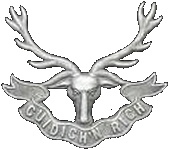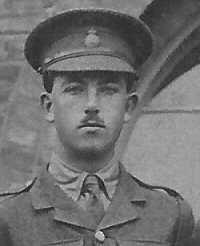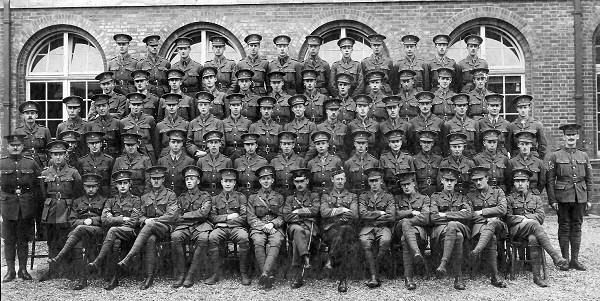
Ashtead War Memorials - WWI - 2nd Lt Philip Cranstoun Grove, Seaforth Highlanders

SECOND LIEUTENANT PHILIP
CRANSTOUN GROVE
SEAFORTH HIGHLANDERS
| Who was reported missing on
April 11, and who is now officially reported to have
fallen whilst leading his company into action on that
date, was the only son of Mr and Mrs John Worrall Grove
of Ashtead, Surrey, grandson of the late Philip Grove of
Eastcote, Northamptonshire, and only grandson of the late
Watson Cranstoun Duncan, of Ceylon and Ryde, Isle of
Wight. He was educated at Sherborne and Sandhurst*, and obtained his commission on November 24, 1915, 4 days after his 19th birthday. His commanding officer writes:- “Your boy has been throughout an example to those under him, and I cannot express how deeply we all mourn his loss. He and I were friends from the day he joined us, and I miss him terribly. On the day he was splendid, coolness itself, and giving his steadiness to his men.” *Philip C Grove was a member of D Coy., Royal Military College, June 1915. He was the son of John Worrall Grove and Isabel Margaret Grove, of Eastcote, Ashtead, Surrey. He is buried in grave III. D. 28, BROWN'S COPSE CEMETERY, ROEUX. |
 This photo of him dates from Sandhurst, June 1915. source: Great War Forum |

D Company, Sandhurst, June 1915: Philip Grove is 2nd from right,
back row.
How many of these men came home from the Great War?: courtesy
Christopher Jordan, via June Underwood
In September 1911, two freshmen of the Sherborne School, Arnaldo S. Cortesi and Philip C. Grove, found a piece of bone about five inches long, similar to the anterior rib of the Mongolian wild horse, in a dry valley in Dorset. An outline drawing of the head and forequarters of a horse illustrated the smooth convex face of the bone. The artifact commanded interest because it had been found in a Pleistocene deposit of debris from a quarry and because only one comparable object had ever been found in England, at the Robin Hood Cave, Creswell Crags. The Geological Society heard the first public announcement of this find at its March 11, 1914, meeting. A. S. Kennard, in the ensuing discussion, emphasized the rarity of the specimen. Other people thought it certainly of some Paleolithic industry. Smith Woodward described it.
After Philip Grove’s death there was, however, much debate on the authenticity of the discovery and it was not until 1995 that a report in Nature confirmed that the piece was not Paleolithic but an “innocent hoax”
Philip Grove at war in Dewdrop Trench Area 19 October 1916: -
Conditions as described by Capt. Alfred Bundy, 2nd
Middlesex Regiment
" Visited trenches to be taken over and we are to
do a "show". I have never seen such desolation. Mud
thin, deep and black, shell holes full of water, corpses all
around in every stage of decomposition, some partially devoid of
flesh, some swollen and black, some fresh, lying as if in
slumber. One bolt upright, a landmark and guide, another bowed as
if trying to touch his toes. Our trenches are little more than
joined up shell holes, mostly with 12 inches of water above 12
inches of mud. A sunken road provides the only access under cover
and this is almost constantly under shellfire. The casualties on
this road are terrible. I had a very narrow escape myself. A 5.9
shell plunged into the mud just in front of me and did not
explode - 1000 to 1 chance. I was smothered with slime and had to
scrape it out of my eyes to see. Passed several derelict tanks on
our way back to Trones wood camp where we have nothing but
bivouacs. Weather cold and wet. Sat in deep shell holes for
shelter completely and utterly miserable."
War Diary of 2nd Seaforth Highlanders, 20th. October
1916
Still bitterly cold - a large working party went out at night to
dig or rather fill in old trenches just East of GUILLEMONT. The
party had 14 casualties owing to some live bombs or dud shells
being struck by a pick or shovel.
ARRIVALS, DEPARTURES AND CASUALTIES
2/Lieut PG Grove, HRV Jameson and servants rejoined from
4th Division School.
13 men wounded (2 of which died of wounds).
41 reinforcements joined.
War Diary of 2nd Seaforth Highlanders, 23 October 1916
We moved right through LESBEOUFS being very fortunate
with regard to casualties, considering the fact that the place
was being plastered by very heavy shells.
When the head of the column reached the SUNKEN ROAD, running just to the East of the village, two very big shells burst right among us. One of them accounted for every signaller who was with us, killing all except one who was very badly wounded. The Battalion moved into BURNABY, FOGGY AND SHAMROCK TRENCHES. Battalion H.Q. settling down in BURNABY TRENCH. We remained here, sending messages in every direction, to try and ascertain any news we could. However we could hear nothing for definite, and the situation was certainly very vague. We could see our red flares burning on the ridge in front, and at the same time the enemy were sniping at us from very close range. After we had settled down in these trenches, we got a very heavy shelling for two hours. The trench was in a dreadful state, almost non-existent in many places. Darkness came on and still no word came in. We decided before long that DEWDROP AND RAINY TRENCHES were still in the enemy's hands and that the 11th. Brigade on the right had taken the GUN PITS and the ridge just in front. About 3 p.m. the rain came, and it was a very wet night. The enemy were putting their flares right into our trench where they proceeded to burn very brightly for a few seconds. About 10 p.m. the Colonel and Adjutant went back through LESBEOUFS to the Battalion H.Q. in the assembly trenches, where the telephone was. On arrival there they found a message, ordering us to take DEWDROP TRENCH at all costs. Following a brief telephone conversation with the Brigadier o the 12th Brigade, it was decided that such an attack would be absolute madness, and could only result in one thing- the annihilation of the Battalion. Surprise would have been quite impossible, considering the enumerable flares and the awful state of the ground, and without surprise, the attack would be futile. The General then ordered the Colonel to withdraw the Battalion from the trenches. It was then midnight. The casualties of the day are noted below. The Divisional attack had, to all intents and purposes, failed, though some ground had been gained on the right.
ARRIVALS DEPARTURES AND CASUALTIES
13 KILLED
3 DIED OF WOUNDS
21 WOUNDED
2/Lieut PC Grove wounded, remained at duty.
It was on this day That Sergeant Robert Downie of the 2nd. Royal
Dublin Fusiliers won his Victoria Cross.
source: FALLEN OFFICERS - THE TIMES LIST OF CASUALTIES - (IN ADDITION TO THOSE PUBLISHED IN THE OFFICIAL LISTS), via Brian Bouchard, L&DLHS
Brian Bouchard adds: An In Memoriam notice appeared in The Times:
"In proud and loving memory of Philip Cranstoun Grove, 2nd Lieut (Acting Capt.), 2nd Batt., Seaforth Highlanders who fell in action at the Battle of Arras, 11 April 1917. Only son of Mr & Mrs John Worrall Grove, Ashtead, aged 19½"
If you can add to this page please contact the editor.
page added 3 Feb 2009: updated 15 May 2009